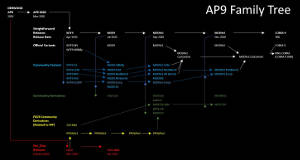¶ Shuty Family
Derwood's "Shuty" is a series of hybrid printed 9mm carbines best known for being both the earliest semiautomatic firearm that was mostly printed, and the progenitor of several other firearms, most notably the FGC-9, WTF-9, and MOD-9. They were named after the Luty submachine gun, a famous homebuilt firearm.
All variants of the Shuty design are 9mm carbines designed to use a printed receiver similar to many printed versions of the AR-15. The Shuty was designed less for public distribution and more as a proof of concept, but evolved into more easily built variants over time. One of the key limiting factors of the design was a need for a Glock barrel, which still prevents the Shuty from being manufactured in most countries. As there are many 9mm carbine designs that are far easier to build, either using a parts kit or building from scratch, all Shutys are functionally obsolete.
The AP-9, in all its variants, is an AR-15 based 9mm carbine. As a primarily printed design its construction involves a lot of plastic, some fasteners, jigs for cutting large chunks of metal into the required shape, and perhaps most importantly a standard Glock G-17 barrel.
Far from being an easy or well documented build, the Shuty is the seed that grew into an entire family of 9mm carbines. The original Shuty should not be built as the design has been improved upon several times.
¶ Shuty Family
The Shuty family was developed by Derwood while he was a part of FOSSCAD (on IRC). Derwood created his own group to focus on further developing his own designs and provide support for his designs at Weight Forward.
The AP9 family members are (in chronological order):
-
Shuty (V2) - The Shuty was the original proof of concept design, and was made using a proprietary printed magazine in concert with a mostly unmodified printed AR type lower receiver.
-
Shuty MP-1 (V4) - The MP-1 was a major step forward in the Shuty's development cycle by proving the design could be made to work without a need for an AR buffer tube, as the original Shuty used. It still used a homemade magazine, which significantly limited its reach.
-
Gluty - The Gluty was named for the fact it could take Glock-pattern magazines instead of homemade ones, significantly increasing the utility of the design. For one reason or another, the Gluty's successor did not have the lack of a buffer tube.
-
Shuty AP9 (V1.2) - The Shuty AP9 was the most refined version of Shuty platform. While reverting back to the use of a buffer tube, it had much finer fit and finish when compared to earlier models, and was for many years the gold standard of printed pistol caliber carbines. The AP9 design was directly spun off into numerous forks, which form a large portion of the current homemade carbine market.
-
AP9 2020 - Very little differs from the AP9 itself, but the release allowed people who wanted to do so to make their own significantly easier than they did before.
¶ Derivatives
-
FGC-9 by JStark1809 and members of Deterrence Dispensed. The FGC-9 was a thorough reworking of the Shuty design that focused heavily on ease of manufacture by the builder. Significant advances such as home manufacture of springs, printable fire control groups, and electrochemically machined barrels significantly contributed to the popularizing of the FGC-9.
-
WTF-9 by Derwood. The WTF-9 was the conceptual successor by Derwood himself to the AP-9, featuring many improvements to make the gun a better carbine. It was less easy to build than the FGC-9, and is most known for its own successor: the MOD-9.
¶ Links
WFGCI Website - Community welcome page with details
Derwood's DefCAD page
WFGCI Github

